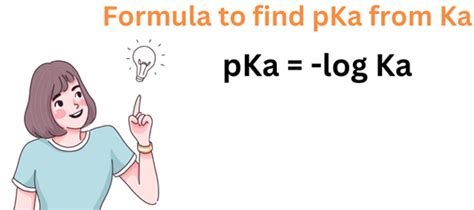How to Get pKa from Ka: A Simple Guide for Chemists
Understanding the relationship between Ka and pKa is crucial in chemistry, particularly when dealing with acid-base equilibria. While Ka (acid dissociation constant) directly quantifies the strength of an acid, pKa offers a more user-friendly scale for comparison. This guide will walk you through how to easily calculate pKa from Ka, along with helpful tips and examples.
Understanding Ka and pKa
Before diving into the calculation, let's briefly review the definitions:
-
Ka (Acid Dissociation Constant): This is the equilibrium constant for the dissociation of an acid in water. A higher Ka value indicates a stronger acid, meaning it dissociates more readily.
-
pKa (Negative Logarithm of Ka): The pKa is simply the negative logarithm (base 10) of the Ka value. This logarithmic transformation provides a more manageable scale, particularly when dealing with a wide range of Ka values. A lower pKa indicates a stronger acid.
The Simple Formula: From Ka to pKa
The conversion from Ka to pKa is straightforward:
pKa = -log₁₀(Ka)
This means you take the negative logarithm (base 10) of the Ka value to obtain the pKa.
Example Calculation
Let's say you have an acid with a Ka value of 1.8 x 10⁻⁵. To calculate the pKa:
- Input the Ka value: Ka = 1.8 x 10⁻⁵
- Calculate the negative logarithm: pKa = -log₁₀(1.8 x 10⁻⁵)
- Solve using a calculator: pKa ≈ 4.74
Therefore, the pKa of this acid is approximately 4.74.
Tips for Accurate Calculations
- Use a scientific calculator: Standard calculators may not handle logarithmic functions correctly. Ensure you use a calculator capable of calculating logarithms (base 10).
- Significant figures: Pay attention to significant figures in your Ka value. The number of significant figures in your pKa should correspond to the number of significant figures in the decimal part of your Ka value.
- Unit consistency: Ka values are dimensionless, so you don't need to worry about units during the calculation.
Why Use pKa Instead of Ka?
The pKa scale offers several advantages over using Ka directly:
- Easier comparison: pKa values are easier to compare and interpret than a wide range of Ka values spanning several orders of magnitude.
- Simplified representation: The logarithmic scale compresses the range of values, making it easier to handle numerically.
- Better visualization: pKa values are frequently used in graphical representations of acid-base equilibria, such as titration curves.
Beyond the Basics: Applications of pKa
Understanding pKa is fundamental in various chemical applications:
- Predicting reaction outcomes: pKa values help predict whether a reaction will favor product formation or remain largely unreacted.
- Buffer solution design: Knowing the pKa of a weak acid is essential for designing effective buffer solutions.
- Drug discovery and development: pKa is a crucial parameter in understanding the behavior of drugs within the body.
By mastering the simple conversion from Ka to pKa, you'll gain a deeper understanding of acid-base chemistry and its numerous applications. Remember the formula: pKa = -log₁₀(Ka) and practice with different Ka values to build your confidence.
